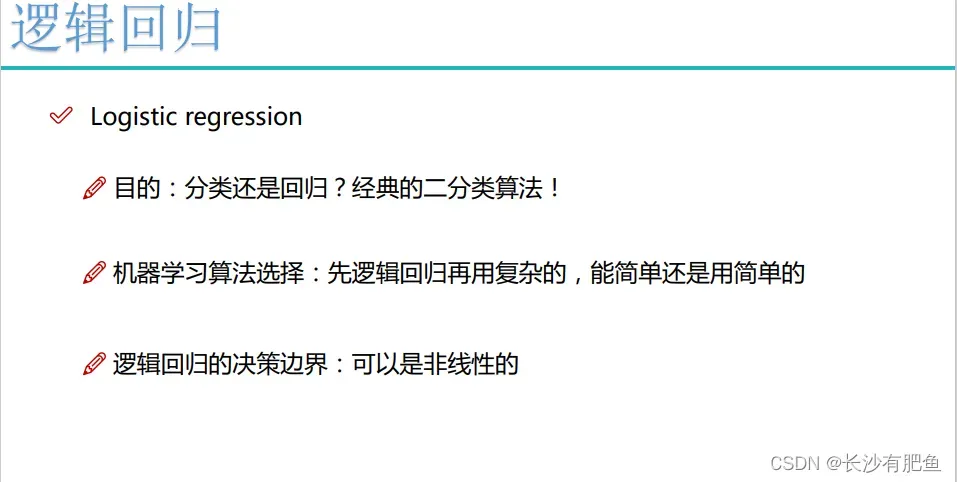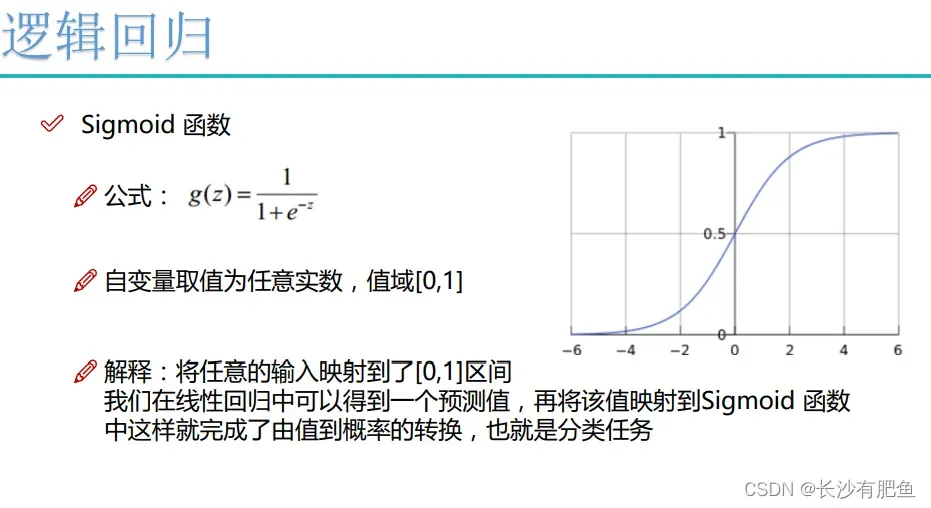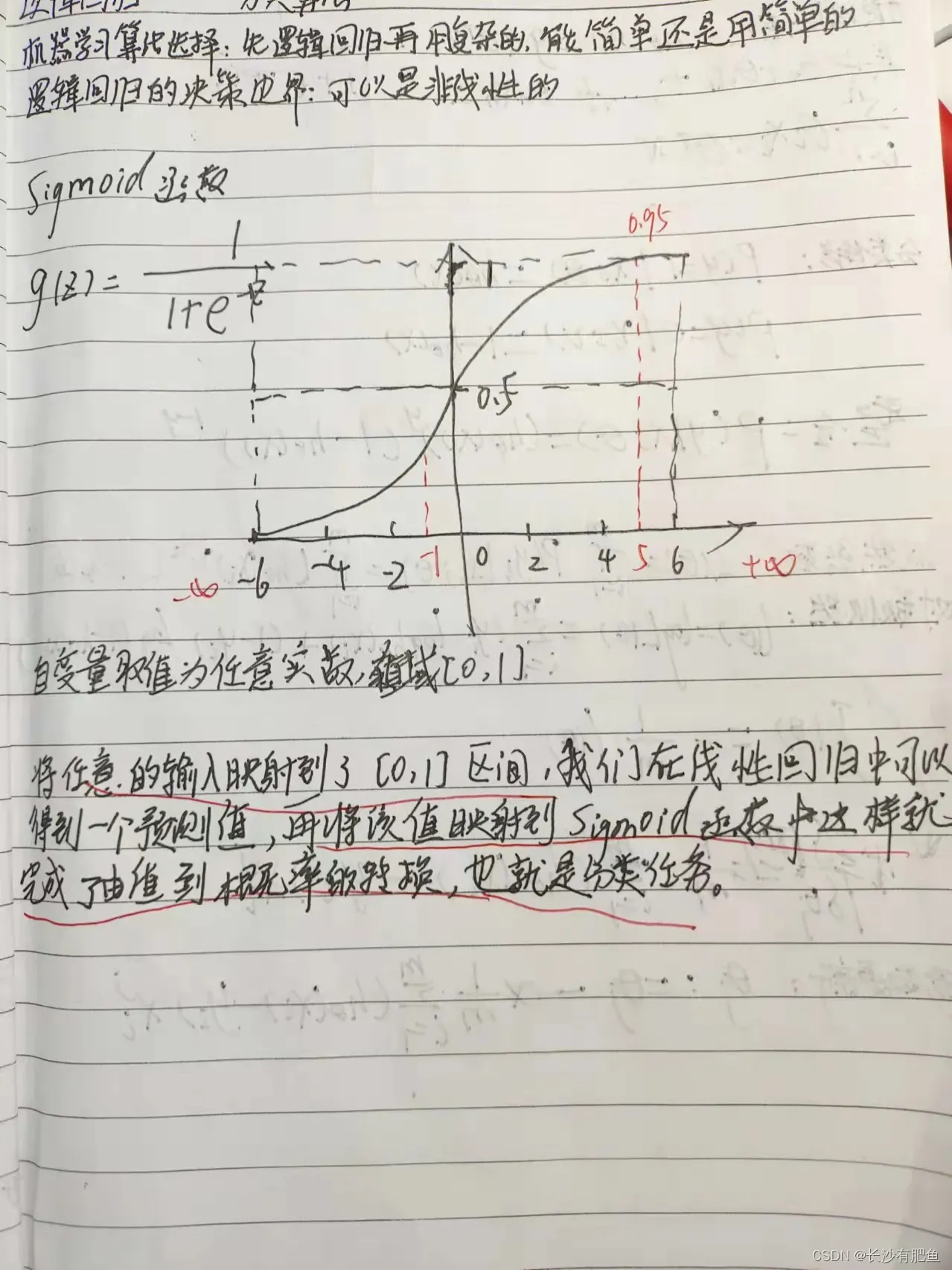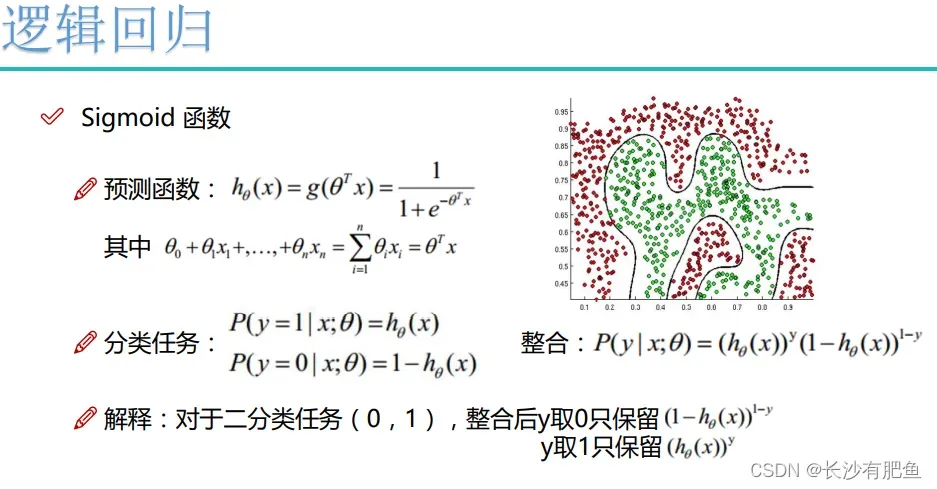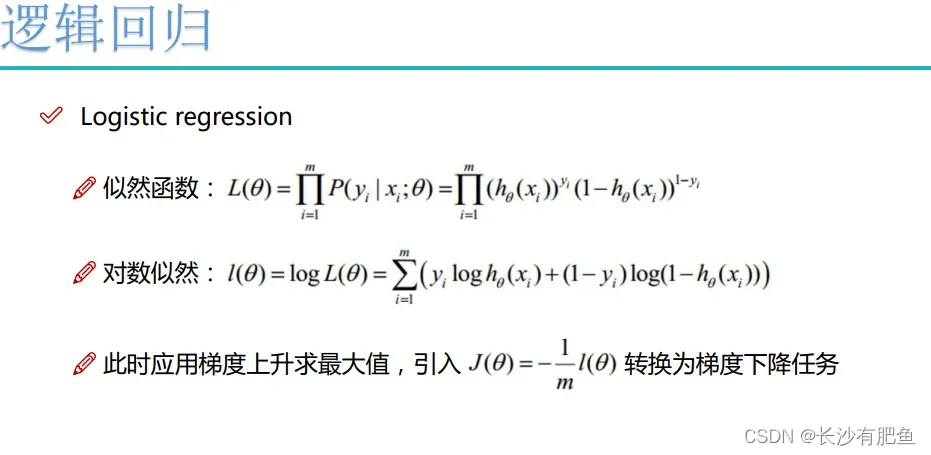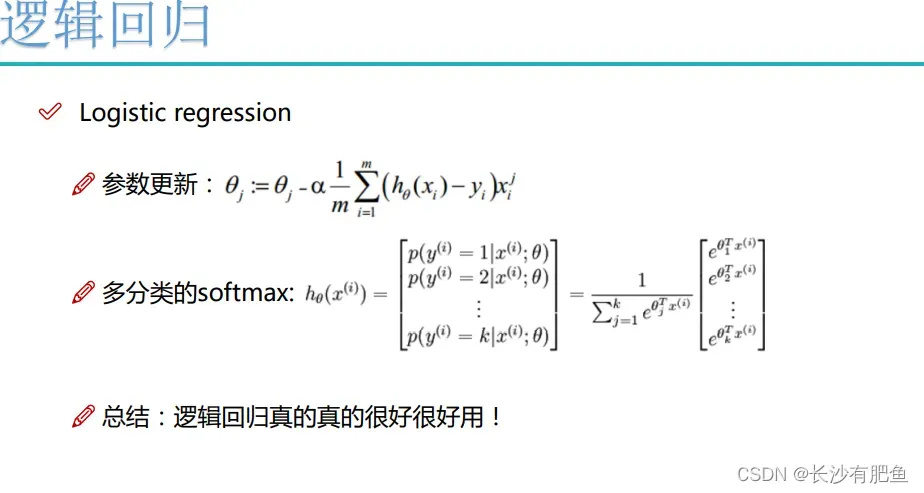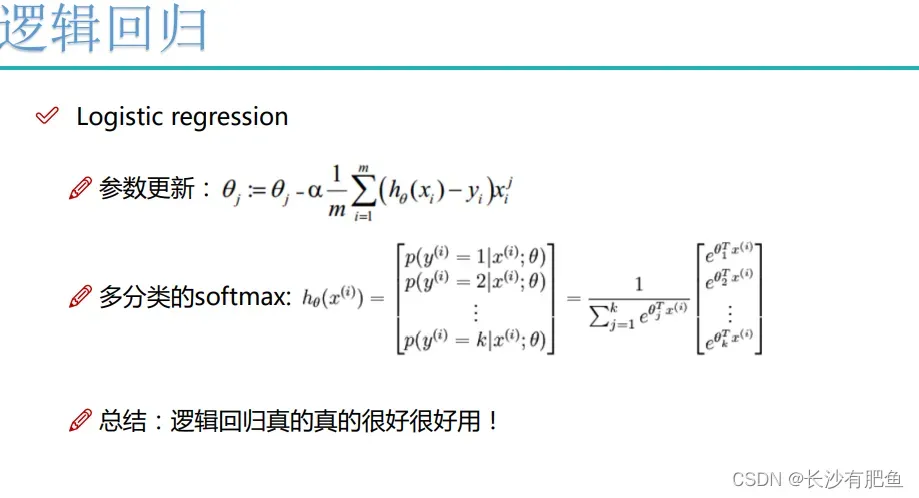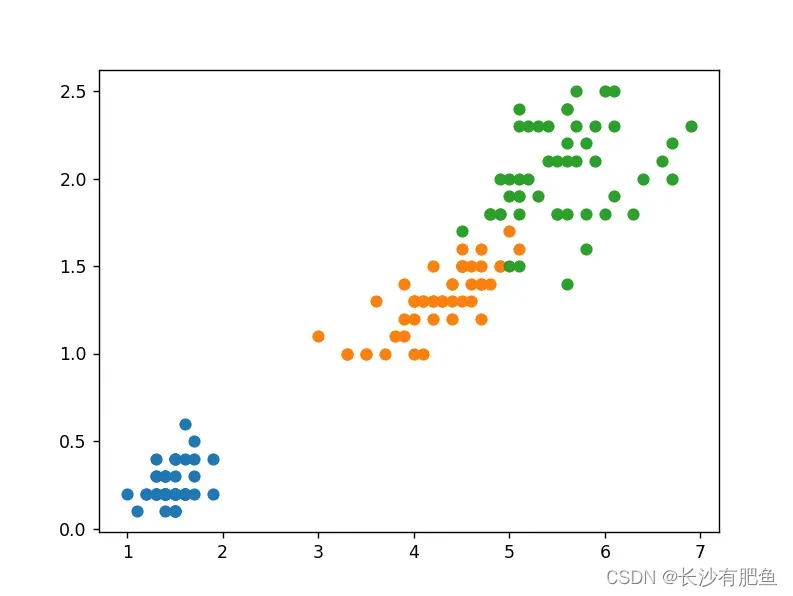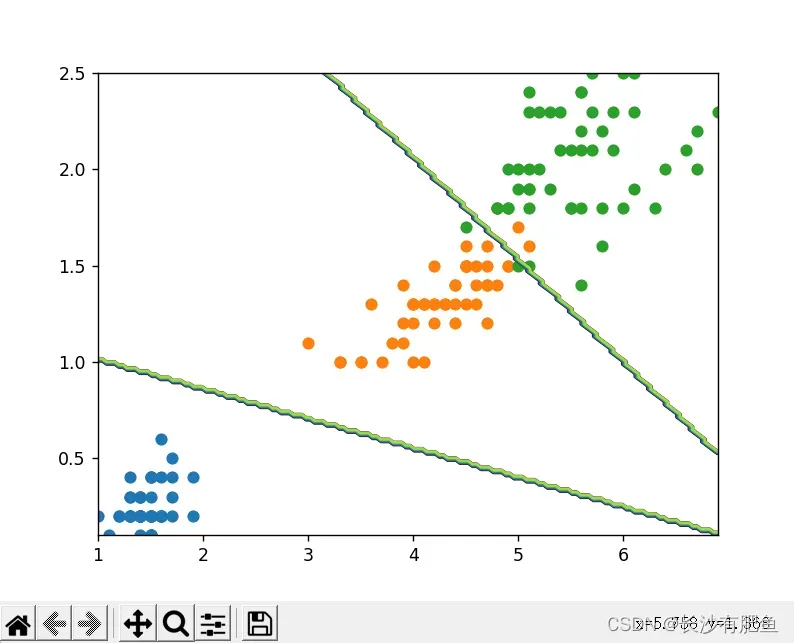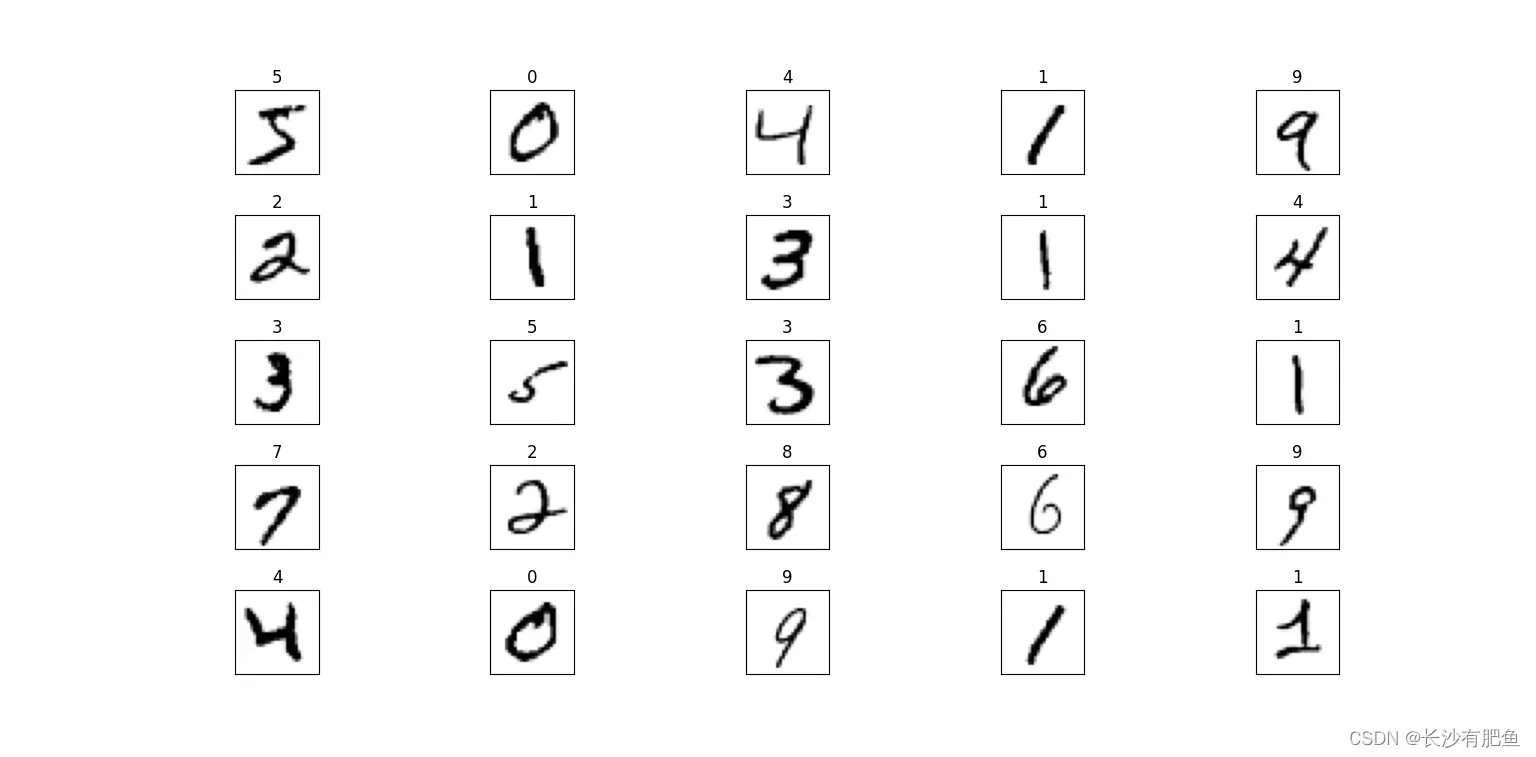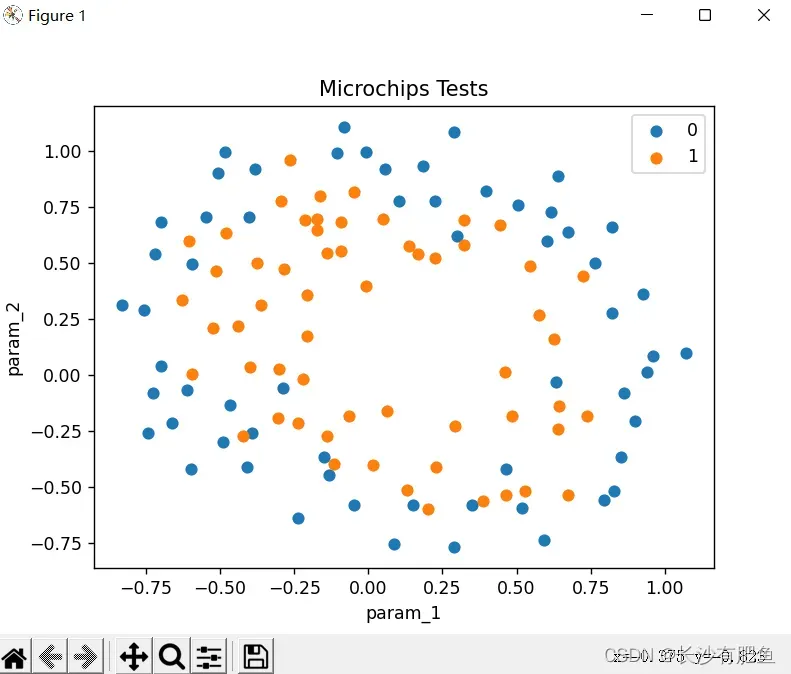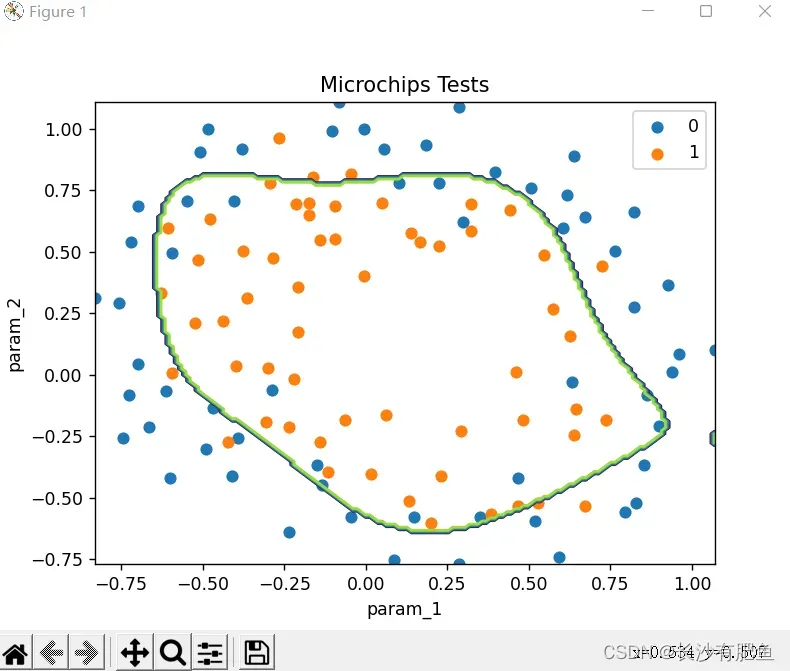概念
逻辑回归是一种分类算法。
线性逻辑回归
logistic_regression.py
import numpy as npfrom scipy.optimize import minimizefrom utils.features import prepare_for_trainingfrom utils.hypothesis import sigmoidclass LogisticRegression: def __init__(self,data,labels,polynomial_degree = 0,sinusoid_degree = 0,normalize_data=False): """ 1.对数据进行预处理操作 2.先得到所有的特征个数 3.初始化参数矩阵 """ (data_processed, features_mean, features_deviation) = prepare_for_training(data, polynomial_degree, sinusoid_degree,normalize_data=False) self.data = data_processed self.labels = labels self.unique_labels = np.unique(labels) # 计算标签的数量 self.features_mean = features_mean # 特征值平均 self.features_deviation = features_deviation self.polynomial_degree = polynomial_degree self.sinusoid_degree = sinusoid_degree self.normalize_data = normalize_data num_features = self.data.shape[1] # 特征的个数 num_unique_labels = np.unique(labels).shape[0] # 特征类别 self.theta = np.zeros((num_unique_labels,num_features)) # num_unique_labels -> 类别 num_features -> 特征个数 # 定义训练函数 def train(self,max_iterations=1000): cost_histories = [] # 将损失值记录下来 num_features = self.data.shape[1] for label_index,unique_label in enumerate(self.unique_labels): # unique_label -> 标签值 current_initial_theta = np.copy(self.theta[label_index].reshape(num_features,1)) current_labels = (self.labels == unique_label).astype(float) # self.labels == unique_label判断当前标签与训练标签是否一样 (current_theta,cost_history) = LogisticRegression.gradient_descent(self.data,current_labels,current_initial_theta,max_iterations) # self.data —> 数据 current_labels -> 标签 current_initial_theta -> theta值 max_iterations -> 最大迭代次数 self.theta[label_index] = current_theta.T cost_histories.append(cost_history) return self.theta, cost_histories # 梯度下降 @staticmethod def gradient_descent(data,labels,current_initial_theta,max_iterations): cost_history = [] # 初始化为list结构 num_features = data.shape[1] result = minimize( # 要优化的目标: lambda current_theta:LogisticRegression.cost_function(data,labels,current_theta.reshape(num_features,1)), # 初始化的权重参数 current_initial_theta, # 选择优化策略 method='CG', # 梯度下降迭代计算公式 jac=lambda current_theta:LogisticRegression.gradient_step(data,labels,current_theta.reshape(num_features,1)), # 记录结果 callback=lambda current_theta:cost_history.append(LogisticRegression.cost_function(data,labels,current_theta.reshape((num_features,1)))), # 迭代次数 options={'maxiter': max_iterations} ) if not result.success: raise ArithmeticError('Can not minimize cost function'+result.message) optimized_theta = result.x.reshape(num_features,1) return optimized_theta,cost_history # 损失函数 @staticmethod def cost_function(data,labels,theta): num_examples = data.shape[0] predictions = LogisticRegression.hypothesis(data,theta) y_is_set_cost = np.dot(labels[labels == 1].T,np.log(predictions[labels == 1])) # 计算当前是1的损失 y_is_not_set_cost = np.dot(1-labels[labels == 0].T,np.log(1-predictions[labels == 0])) cost = (-1/num_examples)*(y_is_set_cost+y_is_not_set_cost) return cost @staticmethod def hypothesis(data,theta): predictions = sigmoid(np.dot(data,theta)) return predictions # 梯度下降 @staticmethod def gradient_step(data,labels,theta): num_examples = labels.shape[0] predictions = LogisticRegression.hypothesis(data,theta) label_diff = predictions - labels gradients = (1/num_examples)*np.dot(data.T,label_diff) return gradients.T.flatten() # 预测函数 def predict(self,data): num_examples = data.shape[0] data_processed = prepare_for_training(data, self.polynomial_degree, self.sinusoid_degree,self.normalize_data)[0] prob = LogisticRegression.hypothesis(data_processed,self.theta.T) max_prob_index = np.argmax(prob, axis=1) # 返回沿轴的最大值的索引 class_prediction = np.empty(max_prob_index.shape,dtype=object) for index,label in enumerate(self.unique_labels): class_prediction[max_prob_index == index] = label return class_prediction.reshape((num_examples,1))logistic_regression_with_linear_boundary.py
import numpy as npimport pandas as pdimport matplotlib.pyplot as pltfrom logistic_regression import LogisticRegressiondata = pd.read_csv('../data/iris.csv')iris_types = ['SETOSA','VERSICOLOR','VIRGINICA']# 0 = 'SETOSA' 1 = 'VERSICOLOR' 2 = 'VIRGINICA'x_axis = 'petal_length'# 长度y_axis = 'petal_width'# 宽度for iris_type in iris_types: plt.scatter(data[x_axis][data['class'] == iris_type], data[y_axis][data['class'] == iris_type], label=iris_type )plt.show()num_examples = data.shape[0]# 计算样本数量x_train = data[[x_axis,y_axis]].values.reshape((num_examples,2))y_train = data['class'].values.reshape((num_examples,1))max_iterations = 1000polynomial_degree = 0sinusoid_degree = 0logistic_regression = LogisticRegression(x_train,y_train,polynomial_degree,sinusoid_degree)thetas,cost_histories = logistic_regression.train(max_iterations)labels = logistic_regression.unique_labels# 标签# 画出三个二分类plt.plot(range(len(cost_histories[0])),cost_histories[0],label = labels[0])plt.plot(range(len(cost_histories[1])),cost_histories[1],label = labels[1])plt.plot(range(len(cost_histories[2])),cost_histories[2],label = labels[2])plt.show()y_train_prections = logistic_regression.predict(x_train)precision = np.sum(y_train_prections == y_train)/y_train.shape[0] * 100# y_train_prections == y_train -> 表示预测的和训练的一样 y_train.shape[0] -> 样本总数print('precision:', precision)x_min = np.min(x_train[:,0])x_max = np.max(x_train[:,0])y_min = np.min(x_train[:,1])y_max = np.max(x_train[:,1])samples= 150 X = np.linspace(x_min,x_max,samples)Y = np.linspace(y_min,y_max,samples)Z_SETOSA = np.zeros((samples,samples))Z_VERSICOLOR = np.zeros((samples,samples))Z_VIRGINICA = np.zeros((samples,samples))for x_index,x in enumerate(X): for y_index,y in enumerate(Y): data = np.array([[x,y]]) prediction = logistic_regression.predict(data)[0][0] if prediction == 'SETOSA': Z_SETOSA[x_index][y_index] =1 elif prediction == 'VERSICOLOR': Z_VERSICOLOR[x_index][y_index] =1 elif prediction == 'VIRGINICA': Z_VIRGINICA[x_index][y_index] =1 for iris_type in iris_types: plt.scatter( x_train[(y_train == iris_type).flatten(),0], # y_train == iris_type -> 判断当前训练数据是否是当前类型 x_train[(y_train == iris_type).flatten(),1], label = iris_type )# 画出等高图 决策边界plt.contour(X,Y,Z_SETOSA)# 第一个决策边界plt.contour(X,Y,Z_VERSICOLOR)# 第二个决策边界plt.contour(X,Y,Z_VIRGINICA)plt.show()
mnist.py
import numpy as npimport pandas as pdimport matplotlib.pyplot as pltimport matplotlib.image as mpimgimport mathfrom logistic_regression import LogisticRegressiondata = pd.read_csv('../data/mnist-demo.csv')# 绘图设置numbers_to_display = 25num_cells = math.ceil(math.sqrt(numbers_to_display))plt.figure(figsize=(10, 10))# for plot_index in range(numbers_to_display): # 读取数据 digit = data[plot_index:plot_index + 1].values digit_label = digit[0][0] digit_pixels = digit[0][1:] # 正方形的 image_size = int(math.sqrt(digit_pixels.shape[0])) # 转换成图像形式 frame = digit_pixels.reshape((image_size, image_size)) # 展示图像 plt.subplot(num_cells, num_cells, plot_index + 1) plt.imshow(frame, cmap='Greys') plt.title(digit_label) plt.tick_params(axis='both', which='both', bottom=False, left=False, labelbottom=False, labelleft=False)plt.subplots_adjust(hspace=0.5, wspace=0.5)plt.show()# 训练集划分pd_train_data = data.sample(frac=0.8)pd_test_data = data.drop(pd_train_data.index)# Ndarray数组格式train_data = pd_train_data.valuestest_data = pd_test_data.valuesnum_training_examples = 6000x_train = train_data[:num_training_examples, 1:]y_train = train_data[:num_training_examples, [0]]x_test = test_data[:, 1:]y_test = test_data[:, [0]]# 训练参数max_iterations = 10000 polynomial_degree = 0 sinusoid_degree = 0 normalize_data = True # 逻辑回归logistic_regression = LogisticRegression(x_train, y_train, polynomial_degree, sinusoid_degree, normalize_data)(thetas, costs) = logistic_regression.train(max_iterations)pd.DataFrame(thetas)# How many numbers to display.numbers_to_display = 9# Calculate the number of cells that will hold all the numbers.num_cells = math.ceil(math.sqrt(numbers_to_display))# Make the plot a little bit bigger than default one.plt.figure(figsize=(10, 10))# Go through the thetas and print them.for plot_index in range(numbers_to_display): # Extrace digit data。 digit_pixels = thetas[plot_index][1:] # Calculate image size (remember that each picture has square proportions)。 image_size = int(math.sqrt(digit_pixels.shape[0])) # Convert image vector into the matrix of pixels。 frame = digit_pixels.reshape((image_size, image_size)) # Plot the number matrix。 plt.subplot(num_cells, num_cells, plot_index + 1) plt.imshow(frame, cmap='Greys') plt.title(plot_index) plt.tick_params(axis='both', which='both', bottom=False, left=False, labelbottom=False, labelleft=False)# Plot all subplots.plt.subplots_adjust(hspace=0.5, wspace=0.5)plt.show()# 训练情况labels = logistic_regression.unique_labelsfor index, label in enumerate(labels): plt.plot(range(len(costs[index])), costs[index], label=labels[index])plt.xlabel('Gradient Steps')plt.ylabel('Cost')plt.legend()plt.show()# 测试结果y_train_predictions = logistic_regression.predict(x_train)y_test_predictions = logistic_regression.predict(x_test)train_precision = np.sum(y_train_predictions == y_train) / y_train.shape[0] * 100test_precision = np.sum(y_test_predictions == y_test) / y_test.shape[0] * 100print('Training Precision: {:5.4f}%'.format(train_precision))print('Test Precision: {:5.4f}%'.format(test_precision))# How many numbers to display.numbers_to_display = 64# Calculate the number of cells that will hold all the numbers.num_cells = math.ceil(math.sqrt(numbers_to_display))# Make the plot a little bit bigger than default one.plt.figure(figsize=(15, 15))# Go through the first numbers in a test set and plot them.for plot_index in range(numbers_to_display): # Extrace digit data。 digit_label = y_test[plot_index, 0] digit_pixels = x_test[plot_index, :] # Predicted label。 predicted_label = y_test_predictions[plot_index][0] # Calculate image size (remember that each picture has square proportions)。 image_size = int(math.sqrt(digit_pixels.shape[0])) # Convert image vector into the matrix of pixels。 frame = digit_pixels.reshape((image_size, image_size)) # Plot the number matrix。 color_map = 'Greens' if predicted_label == digit_label else 'Reds' plt.subplot(num_cells, num_cells, plot_index + 1) plt.imshow(frame, cmap=color_map) plt.title(predicted_label) plt.tick_params(axis='both', which='both', bottom=False, left=False, labelbottom=False, labelleft=False)# Plot all subplots.plt.subplots_adjust(hspace=0.5, wspace=0.5)plt.show()
非线性逻辑回归
NonLinearBoundary.py
import numpy as npimport pandas as pdimport matplotlib.pyplot as pltimport matplotlib.image as mpimgimport mathfrom logistic_regression import LogisticRegressiondata = pd.read_csv('../data/mnist-demo.csv')# 绘图设置numbers_to_display = 25num_cells = math.ceil(math.sqrt(numbers_to_display))plt.figure(figsize=(10, 10))# for plot_index in range(numbers_to_display): # 读取数据 digit = data[plot_index:plot_index + 1].values digit_label = digit[0][0] digit_pixels = digit[0][1:] # 正方形的 image_size = int(math.sqrt(digit_pixels.shape[0])) # 转换成图像形式 frame = digit_pixels.reshape((image_size, image_size)) # 展示图像 plt.subplot(num_cells, num_cells, plot_index + 1) plt.imshow(frame, cmap='Greys') plt.title(digit_label) plt.tick_params(axis='both', which='both', bottom=False, left=False, labelbottom=False, labelleft=False)plt.subplots_adjust(hspace=0.5, wspace=0.5)plt.show()# 训练集划分pd_train_data = data.sample(frac=0.8)pd_test_data = data.drop(pd_train_data.index)# Ndarray数组格式train_data = pd_train_data.valuestest_data = pd_test_data.valuesnum_training_examples = 6000x_train = train_data[:num_training_examples, 1:]y_train = train_data[:num_training_examples, [0]]x_test = test_data[:, 1:]y_test = test_data[:, [0]]# 训练参数max_iterations = 10000 polynomial_degree = 0 sinusoid_degree = 0 normalize_data = True # 逻辑回归logistic_regression = LogisticRegression(x_train, y_train, polynomial_degree, sinusoid_degree, normalize_data)(thetas, costs) = logistic_regression.train(max_iterations)pd.DataFrame(thetas)# How many numbers to display.numbers_to_display = 9# Calculate the number of cells that will hold all the numbers.num_cells = math.ceil(math.sqrt(numbers_to_display))# Make the plot a little bit bigger than default one.plt.figure(figsize=(10, 10))# Go through the thetas and print them.for plot_index in range(numbers_to_display): # Extrace digit data。 digit_pixels = thetas[plot_index][1:] # Calculate image size (remember that each picture has square proportions)。 image_size = int(math.sqrt(digit_pixels.shape[0])) # Convert image vector into the matrix of pixels。 frame = digit_pixels.reshape((image_size, image_size)) # Plot the number matrix。 plt.subplot(num_cells, num_cells, plot_index + 1) plt.imshow(frame, cmap='Greys') plt.title(plot_index) plt.tick_params(axis='both', which='both', bottom=False, left=False, labelbottom=False, labelleft=False)# Plot all subplots.plt.subplots_adjust(hspace=0.5, wspace=0.5)plt.show()# 训练情况labels = logistic_regression.unique_labelsfor index, label in enumerate(labels): plt.plot(range(len(costs[index])), costs[index], label=labels[index])plt.xlabel('Gradient Steps')plt.ylabel('Cost')plt.legend()plt.show()# 测试结果y_train_predictions = logistic_regression.predict(x_train)y_test_predictions = logistic_regression.predict(x_test)train_precision = np.sum(y_train_predictions == y_train) / y_train.shape[0] * 100test_precision = np.sum(y_test_predictions == y_test) / y_test.shape[0] * 100print('Training Precision: {:5.4f}%'.format(train_precision))print('Test Precision: {:5.4f}%'.format(test_precision))# How many numbers to display.numbers_to_display = 64# Calculate the number of cells that will hold all the numbers.num_cells = math.ceil(math.sqrt(numbers_to_display))# Make the plot a little bit bigger than default one.plt.figure(figsize=(15, 15))# Go through the first numbers in a test set and plot them.for plot_index in range(numbers_to_display): # Extrace digit data。 digit_label = y_test[plot_index, 0] digit_pixels = x_test[plot_index, :] # Predicted label。 predicted_label = y_test_predictions[plot_index][0] # Calculate image size (remember that each picture has square proportions)。 image_size = int(math.sqrt(digit_pixels.shape[0])) # Convert image vector into the matrix of pixels。 frame = digit_pixels.reshape((image_size, image_size)) # Plot the number matrix。 color_map = 'Greens' if predicted_label == digit_label else 'Reds' plt.subplot(num_cells, num_cells, plot_index + 1) plt.imshow(frame, cmap=color_map) plt.title(predicted_label) plt.tick_params(axis='both', which='both', bottom=False, left=False, labelbottom=False, labelleft=False)# Plot all subplots.plt.subplots_adjust(hspace=0.5, wspace=0.5)plt.show()
版权声明:本文为博主长沙有肥鱼原创文章,版权归属原作者,如果侵权,请联系我们删除!
原文链接:https://blog.csdn.net/weixin_53660567/article/details/123160915

